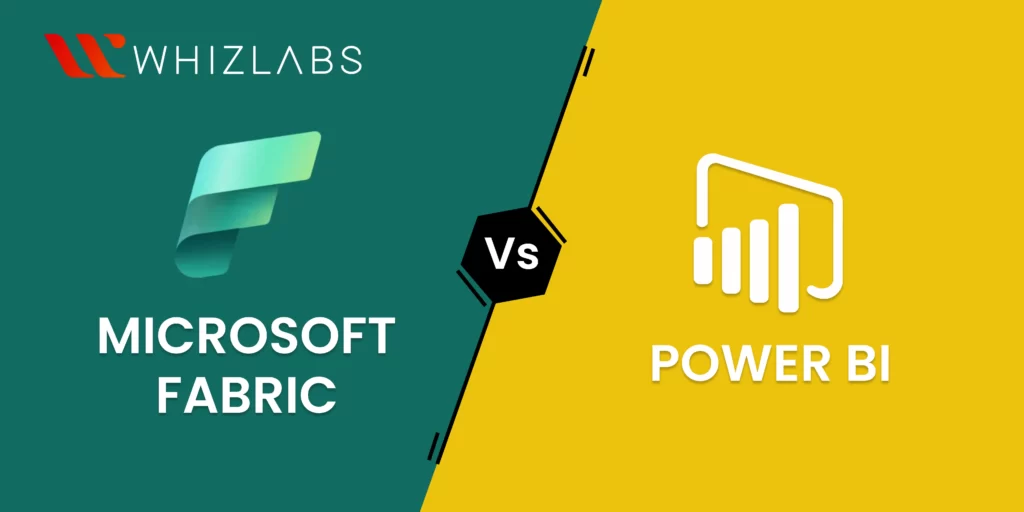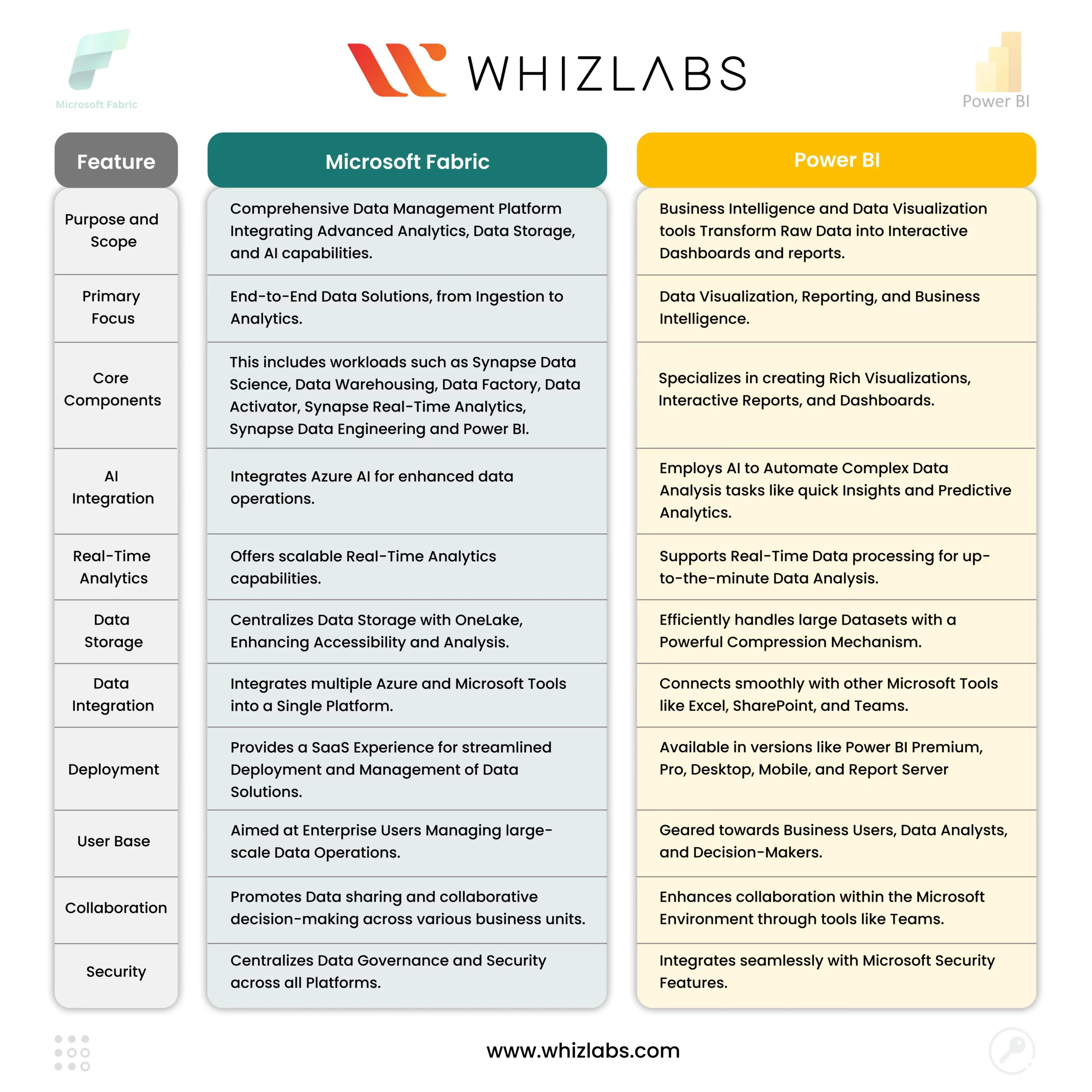In this blog, we’ll explore how Microsoft Fabric and Power BI can help you unlock the full potential of your data in today’s AI-powered world. Whether you’re looking to build scalable analytics solutions or create impactful dashboards, getting certified with exams like DP-600 for Microsoft Fabric and PL-300 for Power BI is a great way to sharpen your skills and boost your career in data analytics.
But which data analytics tool is best suited for your needs? What is the difference? What are the factors to consider when choosing between the two? This blog will cover everything you need to know about Power BI and provide in-depth answers to these questions.
What is Microsoft Fabric?
Microsoft Fabric is a comprehensive data management platform integrating advanced analytics, data storage, and AI capabilities into a cohesive framework. Built on Microsoft’s multi-cloud data lake, OneLake, Fabric offers a Software-as-a-Service (SaaS) experience, enabling businesses to seamlessly manage, analyze, and visualize their data.
By combining the features of existing Microsoft tools like Azure Synapse and Power BI, Fabric creates a streamlined environment for enterprise data solutions.
The platform includes seven core workloads:
- Synapse Data Science
- Synapse Data Warehousing
- Data Factory, Data Activator
- Synapse Real-Time Analytics
- Synapse Data Engineering
- Power BI
Each workload is designed to function cohesively within the unified architecture, allowing businesses to handle complex data processes from ingestion to insights within a single interface. This integration promotes efficiency and eliminates the need for multiple disparate tools.
As an end-to-end solution, Microsoft Fabric simplifies the storage and management of large volumes of data while enhancing data accessibility and intelligence across organizations. Launched in preview at Microsoft Build 2023, it aims to support enterprises by providing all necessary tools for data integration, engineering, and analytics in one place, facilitating better communication and decision-making across various business units.
Features of MS Fabric
- Unified Analytics Platform: Combines data science, BI, and real-time analytics in one solution.
- OneLake Core: Centralized data storage, enhancing accessibility and analysis.
- Scalable Real-Time Analytics: Empowers businesses to process and analyze data as it arrives.
- AI Integration: This feature incorporates Azure AI to streamline and enhance data operations. Starting May 20th, 2024, Copilot in Microsoft Fabric will be enabled by default for all tenants.
- Comprehensive Data Solutions: Merges existing and new Azure functionalities, providing a robust environment for all data needs.
- Innovative User Assistance: Features like GPT-powered Copilot help optimize data workflow and decision-making.
- Enhanced Security: Centralized data governance and security across all platforms.
What is Power BI?
Microsoft Power BI is an effective business intelligence tool that changes complex data into actionable insights with rich visual representations and detailed reporting. This self-service tool is easy to use and it allows businesses to make decisions using raw data that is converted into comprehendible charts, dashboards, and reports.
Regardless of whether that data is in an Excel spreadsheet or Azure, or SQL databases, Power BI opens it up and makes it interesting, and, in effect, this tells the story behind the numbers.
Power BI also performs well in integration functionality, where it combines data from multiple sources via pre-built connectors to present a single view of information.
The platform enables real-time analytics, providing users with the opportunity to view real-time data and work together using Microsoft ecosystem tools such as Teams and Excel. Also, being an AI-based tool, it provides more advanced analytics capabilities, including image recognition, text analytics, which also contributes to the data visualization process.
Features of Power BI
- Custom Visuals with Python: This module supports custom visualizations using Python’s data-viz libraries, allowing for personalized and intricate graphical representations.
- Large Data Sets: Efficiently handles large datasets with a powerful compression mechanism to streamline insight extraction.
- Versatile Application Integration: This includes various versions, such as Power BI Premium, Pro, Desktop, Mobile, and Report Server, catering to different user needs.
- Interactive Reports: Offers various visualization styles, from graphs and charts to scatter plots, enhancing data report aesthetics and understanding.
- Collaboration and Sharing: Integrates seamlessly within the Microsoft environment, facilitating data sharing and collaborative decision-making through applications like SharePoint and Teams.
- Automated AI Insights: Employs AI to automate complex data analysis tasks, such as quick insights and predictive analytics, making advanced data science accessible to all users.
- Real-Time Data Processing: Enables real-time data analysis, ensuring that decision-makers have the most current information at their fingertips.
- Data Integration: Smoothly connects with other Microsoft tools, allowing users to merge and analyze data across platforms for enriched insights.
Microsoft Fabric vs Power BI: What’s The Difference
Microsoft Fabric and Power BI offer unique data management and analytics capabilities, yet they serve distinct organizational roles. Here’s a detailed comparison to highlight how each platform caters to different aspects of your data needs:
Purpose of Platforms
Microsoft Fabric is a fully featured analytics solution that targets businesses. It will offer a unified interface between the business users and the data analysts with the objective of enabling seamless collaboration between the two. Fabric covers data movement, data science, real-time analytics, and business intelligence, among others.
Microsoft Fabric removes the intricate nature of enterprise analytics by combining a wide range of analytics processes on a single system that is simpler and closer to businesses due to its ability to support businesses of all sizes.
Power BI, however, is a business intelligence-oriented interactive data visualization software. It is developed as a tool to process raw and unrelated data sources into legible, visual, immersive, and interactive insights.
The ultimate purpose of Power BI is to enable businesses to make the right decisions through a comprehensive visualization of the data.
Integration Capabilities
Microsoft Fabric integrates multiple technologies, such as Data Science, Data Engineering, Real-Time Analytics, and Power BI, into a unified SaaS platform. This deep integration offers numerous benefits, including comprehensive analytics, shared user experiences across different tools, and a unified data lake that supports and connects various analytics processes.
Power BI also demonstrates impressive integration capabilities, effortlessly connecting with diverse data sources such as databases, webpages, or structured files. However, unlike Fabric, Power BI is primarily an independent business intelligence tool focused on deriving actionable insights from data.
Microsoft Fabric vs Power BI: Architecture and Components
Fabric is built on a robust architecture comprising various components:
- Data Lake: A secure and scalable repository that stores all data formats and structures.
- Data Engineering: An integrated suite for transforming and preparing data, optimizing it for insightful analysis.
- Data Integration: Platforms connecting various data sources for seamless movement and synchronization.
- Machine Learning: A platform for developing and deploying advanced machine learning models.
- Business Intelligence: Specialized tools for data visualization and in-depth analysis, translating raw data into actionable insights.
Power BI’s ecosystem, compared to Fabric, includes
- Power BI Desktop: A desktop application for creating and publishing reports and dashboards.
- Power BI Online: A cloud-based service offering functionalities similar to Power BI Desktop, accessible from any online system.
- Power BI Mobile: Applications for iOS, Android, and Windows devices, enabling users to view and interact with reports and dashboards on the go.
Will MS Fabric Replace Power BI?
The other misconception is that Microsoft Fabric would replace Power BI, but that is not the case. MS Fabric widens the capabilities of Power BI and comprises such functions as data preparation and integration etc.
Power BI is excellent in interactive dashboard and report building, whereas Microsoft Fabric supports it and focuses on the challenges of data preparation and integration. Fabric is a powerful platform with many tools, such as AI-based facilities and data analysis features, which makes it a complete package of solutions to various tasks with data.
Microsoft Fabric vs. Power BI: Which One Is Right For You?
The best choice for you depends on your specific needs and requirements. Microsoft Fabric is an excellent option if you are looking for a comprehensive analytics solution that can manage your entire data pipeline.
The all-in-one approach is ideal for businesses investing in multiple tools and technologies to maintain data cycles. On the other hand, if you need a BI tool to visualize and analyze your data, Power BI is the way to go. It’s user-friendly and packed with features that help non-technical users maximize the value of their data.
Microsoft Fabric vs Power BI: What To Consider When Choosing One
Consider these three things before you settle on one of these data tools.
Scalability:
Both Microsoft Fabric and Power BI are scalable solutions. However, with its comprehensive suite of services, Microsoft Fabric is better suited for large enterprises with complex data analytics needs. Power BI, which provides excellent business intelligence insights through its cloud-based services, is less complex and tailored for users seeking straightforward BI functionality.
Learning Curve:
Microsoft Fabric’s extensive capabilities result in a steeper learning curve than Power BI. Power BI is more intuitive and user-friendly, particularly for those familiar with other Microsoft products like Excel.
Cost:
Power BI offers a free version with limited capabilities, making it accessible for smaller budgets. In contrast, as an all-in-one solution, Microsoft Fabric will likely have a higher price once officially launched. Fabric is free for existing Power BI customers to try out during the preview phase.
Whizlabs offers extensive training materials for both of these certifications. You get numerous practice papers with exhaustive answers and unique questions, nuanced video lectures designed by industry experts, Hands-on labs, and Sandboxes to brush up on your practical skills and experiment in the Azure environment.
Conclusion
This blog spoke about understanding the difference between Microsoft Fabric and Power BI and gaining a holistic view of both tools. Power BI is the primary tool for creating visually appealing and interactive data presentations. Think of it as the front-end artist. Meanwhile, Microsoft Fabric is the backstage technician, ensuring that data is perfectly orchestrated and enriched with insights from advanced analysis and AI-driven algorithms. Want to learn more about these certs? Talk to us today!
- How GCP Cloud Engineers Handle Security & IAM - May 15, 2025
- What Is Amazon Redshift and How Does It Work? - April 28, 2025
- What Is the Role of AWS Lambda in AI Model Deployment? - April 2, 2025
- What Are ETL Best Practices for AWS Data Engineers - March 17, 2025
- How to Create Secure User Authentication with AWS Cognito for Cloud Applications - September 30, 2024
- 2024 Roadmap to AWS Security Specialty Certification Success - August 16, 2024
- Top 25 AWS Full Stack Developer Interview Questions & Answers - August 14, 2024
- AWS Machine Learning Specialty vs Google ML Engineer – Difference - August 9, 2024


